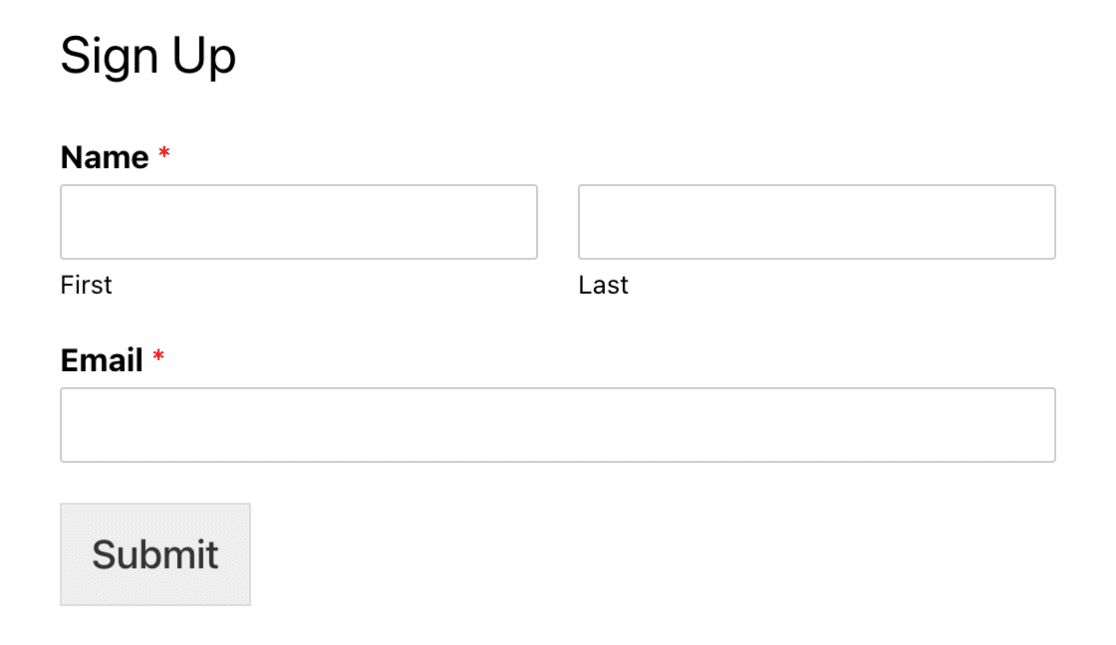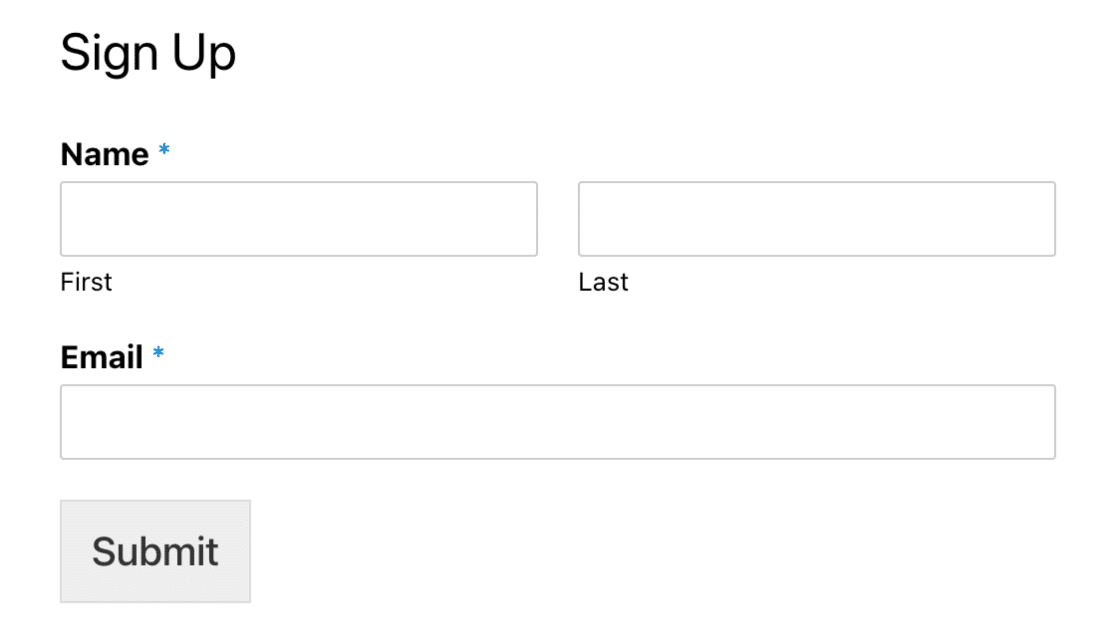My Web Page External Stylesheet Isnt Visible When I Upload to Web Hosting
Have yous created custom CSS for your forms, but haven't been able to encounter those styles when viewing your site? In that location are a few common issues that tin cause CSS not to appear correctly on a site.
In this tutorial, we'll walk through options to troubleshoot why your CSS is non working and offer possible solutions.
- Browser Caching
- Trying a Unlike Browser
- Asking Your Host if They Accept a Cache
- Trying a Unlike Cyberspace Source
- Invalid CSS Format
- CSS Specificity
- Using !important in CSS
Browser Caching
Browsers will oft cache, or temporarily store, resources from websites y'all visit in order to improve load speed. Some sites will too utilise plugins for additional caching. Oftentimes when you don't see your custom styles on your site, it'due south because the browser or other organization has cached an older version of your site.
Here's a tutorial that'll walk you through all of the main steps to clear your site and plugin caches.
If clearing your browser cache doesn't seem to work, here are a couple of additional strategies to try:
Trying a Different Browser
Each browser will keep its own cache of the sites y'all visit. By opening your site in a different browser (or in the private style offered past some browsers, such as Chrome's incognito window), you lot can often come across an uncached version of your site.
Request Your Host if They Have a Cache
Some hosts volition provide caching for your site right in their servers, which is where your site'southward files are stored. If you're non certain, you may want to contact your host to ask if they are caching your site and, if they are, enquire them to clear that cache for yous.
Trying a Unlike Internet Source
Occasionally, just loading your site over a different internet source can help to bypass an existing cache. If yous take a mobile device with available data, the simplest way to do this is to temporarily turn off WiFi on your device and reload the page.
Invalid CSS Format
CSS must be written in a specific format in order for a browser to understand it. There are many online tools to check that your CSS is valid, including W3School'south CSS Validator. This is an excellent option if yous have a lot of custom CSS and at least a petty previous experience creating CSS.
If you are simply using a small-scale amount of CSS, withal, it may sometimes exist easier to do a quick format check of your ain. Let's first by looking at a snippet of valid CSS:
div.wpforms-container-full .wpforms-class .wpforms-championship { font-size: 26px; margin: 0 0 10px 0; } Here's why this CSS is valid, or 'readable' by browsers:
- Correct selector format: If the selector includes multiple parts, it needs to be written from 'biggest' to 'smallest'. In the instance in a higher place,
div.wpforms-container-fullis the biggest container element in the HTML, while.wpforms-formis inside of that container. The smallest and final detail in the selector,.wpforms-title, is contained inside of both of those other elements. In whatsoever other club, the browser won't be able to read this selector. - Two brackets: There must be an opening curly bracket ({) right after the CSS selector and at the end of the property and value list. Forgetting that closing bracket (}) is a common mistake, and volition usually preclude all CSS below it from being shown in the browser.
- Colon and semicolon: Be certain to include a colon (:) between every CSS property and value, and a semicolon (;) after every value so the browser tin read your CSS (for instance,
font-size: 26px;). - Correct use of whitespace: For the virtually part, CSS isn't very picky about whitespace (which includes tabs and spaces). An exception to this, however, is for units.
26pxwill work, for example, while26 pxwill not.
For more than data on writing CSS with proper syntax, you can check out this tutorial from W3Schools.
CSS Specificity
Since all themes and well-nigh plugins contain their own sets of styles, you will often notice that your custom styles must "compete" against existing styles. In such situations, the more specific CSS selector will almost always win out over a less specific selector.
For example, here'southward the default CSS that sets the font size of form titles in WPForms:
div.wpforms-container-full .wpforms-grade .wpforms-title { font-size: 26px; } Let's effort to override that CSS to make the font bigger. It may be tempting to use a curt CSS selector, like this:
.wpforms-title { font-size: 40px; } That CSS is valid, but its styles won't come up through in the browser. The default styles will be applied instead because they accept a more specific selector. Y'all would instead need to use the same, longer selector as the default style for your custom CSS:
div.wpforms-container-full .wpforms-form .wpforms-title { font-size: 40px; } Using !important in CSS
In some situations, you can force a less specific snippet of CSS to piece of work by including the !important rule before the semicolon. It's always better to endeavour a more specific selector (equally described above) get-go, but sometimes this can offer a quick fix.
It's important to notation, however, that calculation the !important rule won't ever work. Let's endeavor this approach for the CSS we discussed in the last example:
.wpforms-title { font-size: 40px !important; } In this situation, the browser prefers the specificity of the default CSS over the !important rule, and then this CSS volition not be applied on your site.
Let'south wait at an example where adding the !of import rule does work. By default, the asterisk (*) that marks a 'required' field in WPForms will be scarlet:

Here is the CSS that creates that style (#ff0000 is a hex lawmaking for the color blood-red):
div.wpforms-container-total .wpforms-form .wpforms-required-label { color: #ff0000; } We want to brand these asterisks appear blueish instead. We could copy that full selector from the CSS to a higher place, or we could utilise a short selector and add the !of import rule, every bit in this CSS snippet:
.wpforms-required-label { color: #007acc !important; } 
Information technology can be tough to know whether or not the !of import rule volition work, so you'll probable need to give information technology a shot and examination it out.
Notation: If you find that you'd similar to write more custom CSS for your forms or any other part of your site, consider checking out CSS Hero, a plugin which allows you lot to manner your forms or site easily without code.
That's it! We've covered the most common troubleshooting strategies to use when CSS isn't working. If you're still having trouble styling your WPForms, delight get in impact with support then nosotros tin aid you out.
Next, would you similar to further customize your forms? Check out our tutorial on customizing private form fields for details and examples.
Source: https://wpforms.com/docs/how-to-troubleshoot-css-not-working/
Postar um comentário for "My Web Page External Stylesheet Isnt Visible When I Upload to Web Hosting"